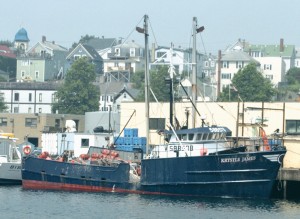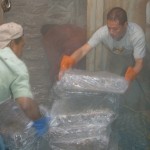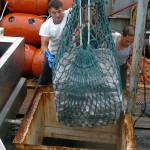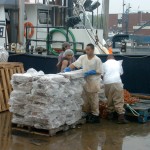by Peter K. Prybot
GLOUCESTER, MA – “In my 72 years along the Gloucester waterfront, I’ve never seen such a professional operation as his,” said George Ingersol, at the dock on a recent summer afternoon.
His compliment was directed at fixed-gear fisherman and fleet owner Jon Williams of Westport, ME, who bases his slime eel operation out of this port.

Jon Williams aboard the Krystle James when she was slime eeling out of Gloucester this summer. (Peter K. Prybot photos)
And it was remarkably high praise considering that Ingersol, a boss lumper, has witnessed lots of fishing vessels, freighters, fishermen, fish, and cargo in his time. Much of his experience comes at the end of the trip, too, when the window dressing is peeled away and you see tired fishermen.
Williams’ company is Benthic Fishing Corp., which either owns or co-owns and operates the deep-sea red crabbers 96’ Hannah Boden, 94’ Diamond Girl, and 83’ Krystle James. The Hannah Boden alternately traps lobsters offshore, while the Krystle James splits her fishing year, also targeting slime eels, which Ingersol helps offload in Gloucester.
Just about everyone who has worked with the 46-year-old Williams, including crew, regulators, scientists, dealers, and marine suppliers, has come to know him not only as an ace fisherman and businessman, but also a creative and positive individual who works hard to make today easier and tomorrow happen.
Williams, the father of two sons, 12 and 14, readily credits much of his success to his wife, Marianne, who has also fished commercially.
“She has supported me all along. She spent 10 years with the two kids while I was in Alaska. She gave birth to my first son while I was hauling king crab traps,” he said.
Williams, the first fisherman in his family, grew up in Mechanic Falls, ME, a mill town, while spending summers at Westport. He began his maritime career at age 13, decking on head boats (charter-type boats that carry more than six people) out of Boothbay Harbor, and later graduating from Maine Maritime Academy.
He has since skippered oil supply and research vessels, fished on the West Coast for crab, and even captained the Hannah Boden for the legendary late Bob Brown.
He purchased the Krystle James, a former Maine scalloper and later midwater trawler, in 1996 and has since expanded his fleet, which targets deep-sea red crab, lobster, and slime eels.
Good people Business principle number one, according to Williams, is employing high caliber people.
“You have to have good people,” he said. “The boat is just a tool. If you don’t have the people, the boat doesn’t matter.” Five years ago Williams hired Bruce Medeiros of New Bedford to manage his fleet.
“Bruce does a fantastic job of keeping everything running and moving. When I was out of the country for two years, Bruce did as good a job, if not a better one, of running the operation than I could have,” said Williams.
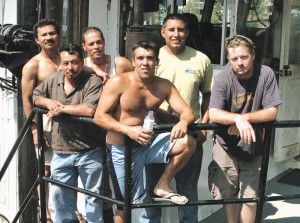
Krystle James crew includes, from left, Loc Tran (Seattle, WA), Daniel Santos (Honduras), Lee Nguyen (Seattle), Daher Jeorge (Seattle), Ed Eliborio (San Lucas, Mexico), and Capt. Jim Stone (Seattle). (Peter K. Prybot photo)
“If we need welding done, fuel, bait, and even our paychecks, we call Bruce,” said Capt. Jim Stone of the Krystle James.
In addition to Stone, the Krystle James’ crew includes Lee Nguyen, Daher Jeorge, and Loc Tran, all from Seattle, WA; Ed Eliborio of San Lucas, Mexico, and Daniel Santos from the Honduras.
Williams likes having West Coast crab fishermen among his crews, many of whom he got to know when he fished there himself.
“I like the Bering Sea work ethic. Those fishermen with it go the extra mile to get the job done,” said Williams. His crews generally work two months on with one month off.
Incidentally, the 45-year-old Stone, his 135’ West Coast crabber Retriever, and crewmen Daher Jeorge and Lee Nguyen were featured in the Discovery Channel’s series “The Deadliest Catch.” These fishermen are good friends of Sig Hansen, the skipper and owner of the highline crabber Northwestern, all featured in the series.
It was filmed in January, according to Stone. The fishermen added that the weather shown “was nothing” compared to what they have worked under. Stone has high regard for Williams.
“Jon is a real good guy. He’s fair. He’s not afraid to spend money on the boats. He keeps them in top shape,” Stone said. “Jon also gives us (the crew) plenty of latitude to work under.” Red crab operation The peak season for red crabbing starts in August and runs through Christmas.
Krystle James made the shift over to red crabs, but will be back slime eeling in January, according to Williams.
During its 190 days-at-sea allotment under Amendment 1 to the deep sea red crab fishery management plan, the Krystle James can fish up to 600 traps. The traps are cone-shaped and made from steel, plastic tubing, and netting, no longer wood, and can land up to 75,000 pounds of crabs per trip.
Crabbing is done on the continental slope in water depths of over 1,000’. The crabs, which earn the vessel 90 cents per pound alive, are processed in Canada and help fill US crab meat demand.
About three years ago several West Coast catcher/processor/freezer crabbing vessels came to the Northeast with the intention of participating in the red crab fishery, which was an open access fishery at the time. There was limited information about the status of the red crab resource and New England boats felt the huge increase in effort could quickly lead to overfishing and depletion of the stock.
They organized the New England Red Crab Harvesters’ Association and, with Williams as president, worked to have limited entry implemented.
“(Williams) was very instrumental in NMFS adopting a fisheries management plan for the red crab,” said Deirdre Boelke, fishery analyst and plan coordinator for the Red Crab Fishery Management Plan.
There are now four boats active in the fishery.
Research In addition to being successful at getting a management plan implemented for the fishery, Williams has continued to push for more information about the species and how to best manage its harvest.
“Jon has been working hard to put the deep-sea red crab on the map and get it certified as a species coming from a sustainable fishery,” said Rick Wahle, a senior research scientist at the Bigelow Center for Marine Sciences at Boothbay Harbor, ME.
He and Williams are in the midst of a longterm research project that is funded by the Northeast Consortium and the Saltonstall-Kennedy Grant Program. They hope to answer more questions about this relatively unknown species’ growth rate, movements, numbers, male to female ratio, and number of females that are egg-bearing.
Sampling is done aboard the Hannah Boden at set survey sites along the continental slope using an otter trawl and a benthic sled fitted with cameras. The data from this project could be used in an upcoming stock assessment for the red crab.
“Jon approached me to do the work. I have found him to be a real team player who has brought along a lot of expertise and a can-do attitude. He is also a pleasure to work with,” said Wahle.
“Jon’s boats are gorgeous. His crews like to work for him, too.” Harvesting co-op In addition, Williams is involved in developing a harvesting cooperative for this fishery and getting the New England Fishery Management Council to approve it.
“We (members of the fishery) are asking the government to go with a straight quota or hard total allowable catch, which the council and scientists will determine. We will manage the fishery ourselves and eliminate a lot of headaches for the government,” he said. “This cooperative will also give us flexibility.” If approved, the red crabbers’ harvesting cooperative will be the firstever on the East Coast.
“This will be definitely cutting edge,” Boelke said.
Eeling out of Gloucester The Krystle James returned to Gloucester early this summer to base its slime eel operation here. The vessel eels to add yearly fishing time to its red crab fishery days-at-sea allotment.
Besides Ingersol, Rose’s Marine and New England Marine Resources Inc. welcomed the return of Krystle James.
“Jon Williams pays his bills, and his organization is very well-run,” said Frank Rose IV, general manager for Rose’s Marine, which sells the Krystle James numerous supplies, especially fuel.
“The quality of his product is excellent, and his vessel is a steady producer,” added Yang Cho, owner of New England Marine Resources Inc., one of Gloucester’s two slime eel buyers and processors, which also exports food-grade eels to South Korea.
- Below-deck, crewmen unloading the frozen-at-sea slime eel catch. The Krystle James’ RSW tank was converted to a freezer for the slime eel operation. The temperature here is minus 9°F during operation. (Peter K. Prybot photo)
- (Peter K. Prybot photo)
- Slime-hoisting–through-hatch (Peter K. Prybot photo)
- The Krystle James catch is sold to New England Marine Resources Inc. (Peter K. Prybot photo)
“Jon is very creative and is not afraid of taking risks. His word means something. Jon and I have been working together the last seven years,” said Cho.
At one time, Williams and Cho coowned the 94’ eel catcher, Camano, though it’s now Cho’s alone.
The Krystle James uses much of its crab fishing deck layout and hauling equipment to harvest the slime eels from deep, offshore, muddy bottoms. The slime eels, or hagfish, are lured into baited traps made out of plastic barrels with entry cones. Twenty-five of these are often fished in a string, which is buoyed at each end.
The boat was the first slime eel vessel to not only store its catch alive in refrigerated sea water (RSW) tanks below deck, but also to vacuum pump them oulike herring at the dock. The vessel has since added a processing line with a plate freezer and converted its RSW tank into a freezer capable of holding 100,000 pounds of bagged eels at -9°F.
Several slime eel vessels were catching, processing, and freezing eels at sea before the Krystle James. Doing so eliminates obnoxious eel wastes and lengthy catch unloading at the dock while the frozen eels are worth 20 cents per pound more than fresh eels, usually in the 60 cents per pound range.
The Krystle James and Diamond Girl established fishing histories in the slime eel fishery in 2001 before a control date went into effect. This still openaccess fishery has ebbed and flowed since it got rolling in the early 1990s.
Gloucester is the East Coast’s slime eel capital.
Currently approximately eight eel boats are working out of this port, which generally sees annual eel landings under 10 million pounds.
About the future, Williams views P & I injury lawsuits as the biggest threat to most fisheries today.
“They will be the ones putting us out of business and not the regulations. My insurance has gone up 400 percent in the last four years,” he said.
“I am pretty comfortable where I’m at today,” Williams said. “I have no desire to have a bigger fleet.”■



